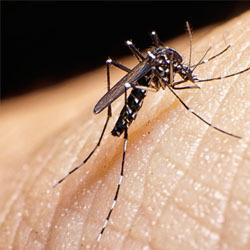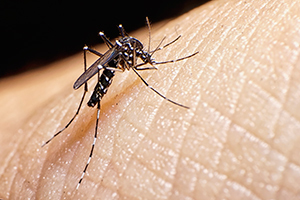
 Aedes aegypti mosquito
Aedes aegypti mosquito
New research from the University of Notre Dame will be used to generate maps that provide time-sensitive estimates of mosquito densities, human birth rates and Zika transmission activity across Latin America and the Caribbean. The model outputs will be available online to provide users with the ability to find reported cases and estimated incidences by location to improve disease transmission and prevalence forecasts, which is critical to making accurate predictions and translating results into effective public health strategies.
The study is being conducted by Alex Perkins, Eck Family Assistant Professor of Biological Sciences and Eck Institute for Global Health affiliated faculty member, who received a rapid response grant (RAPID) from the National Science Foundation’s (NSF) Division of Environmental Biology’s Ecology and Evolution of Infectious Diseases Program for his research proposal that focuses on enabling estimation and forecasting of Zika virus transmission. NSF created these RAPID awards in order to specifically understand the rate of spread, number of infected people and the likely persistence of Zika as a public health threat, and to help prepare for the next outbreak.
“It is exciting to receive this award at this juncture in the epidemic,” said Perkins. “Enough time has passed that we have learned some important basics about Zika’s biology and now have the opportunity to contribute to forecasts of what might happen in coming months as conditions get warmer and wetter in Central America and the Caribbean.”
Results from the project will benefit the Zika public health emergency response, as researchers will have tools in place to share quality data and forecasts both during the study and after the project concludes. This will be a valuable asset for policymakers as they continue to make decisions surrounding this disease.
“This grant will allow us to contribute a number of data and modeling products to the academic and public health communities, including improved estimates of spatial and temporal variation in mosquito densities, improved estimates of spatial variation in birth rates, and mathematical models that better account for unique aspects of Zika’s epidemiology,” Perkins said. “We are serious about communicating this work broadly, with our results being made available online at vecnet.org as they are developed.”
 Alex Perkins
Alex Perkins
Zika is primarily transmitted to humans through the bite of an infected Aedes aegypti mosquito, a species that the University of Notre Dame has nearly 60 years of experience studying. Perkins’ research will provide estimates of Aedes aegypti mosquito density across the Americas as well as updated human population data as it applies to predictions of Zika-infected microcephaly.
“My lab is seeking to prioritize work related to the Zika epidemic as much as possible given the urgency of the situation,” said Perkins. “Having a responsive mechanism like NSF’s RAPID awards is critical for giving us the flexibility to address such a time-sensitive challenge.”
Perkins will work with co-principal investigator Robert C. Reiner Jr., assistant professor of epidemiology and biostatistics at Indiana University, on the $200,000 research project. Other universities to receive one of the nine NSF RAPID grants include Emory University, New York University, the University of Arizona and more.
Perkins is associated with the Eck Institute for Global Health, a University-wide enterprise that recognizes health as a fundamental human right and endeavors to promote research, training and service to advance health standards for all people, especially people in low and middle-income countries, who are disproportionately impacted by preventable diseases.
Contact: Sarah Craig, communications specialist, Eck Institute for Global Health, 574-631-2665, craig.20@nd.edu
Originally published by Brandi Klingerman at news.nd.edu on May 12, 2016.